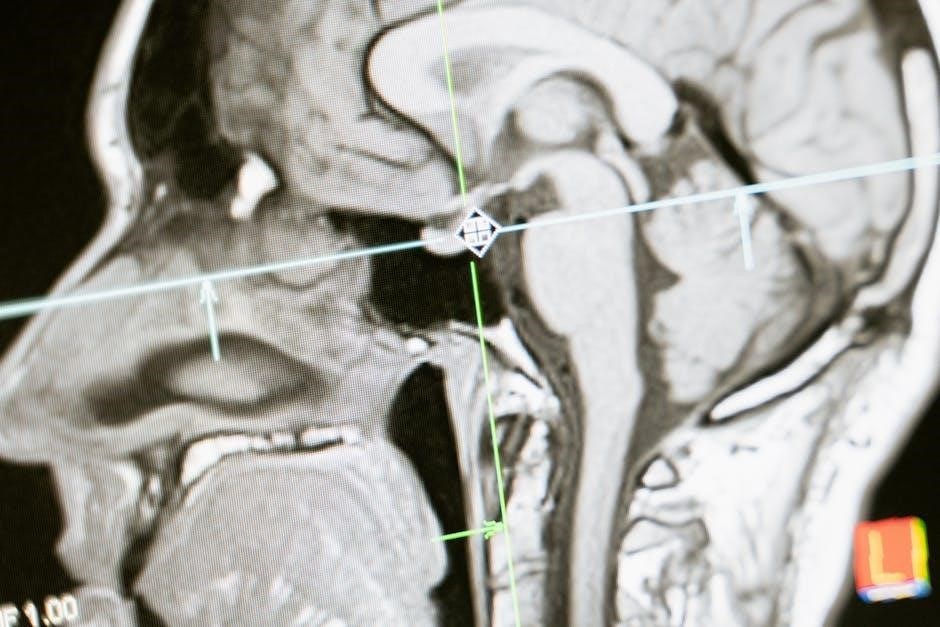The introduction to Holter monitor interpretation involves understanding electrocardiography and its clinical applications‚ using analysis software to detect arrhythmias and other cardiac issues effectively always online.
Overview of Holter Monitoring
Holter monitoring is a type of electrocardiography that records the electrical activity of the heart over a period of time‚ typically 24 to 48 hours. This allows for the detection of arrhythmias and other cardiac issues that may not be apparent during a standard ECG test. The Holter monitor is a small device that is worn by the patient‚ and it records the heart’s electrical activity continuously during the monitoring period. The recorded data is then analyzed using specialized software to identify any abnormalities. The use of Holter monitoring has become a crucial tool in the diagnosis and management of cardiac conditions‚ and its application continues to expand with advances in technology and analysis software. The data collected from Holter monitoring provides valuable insights into the heart’s function and can help guide treatment decisions. Holter monitoring is widely used in clinical settings.
ST Segment Analysis in Holter Monitoring
ST segment analysis is crucial in Holter monitoring for detecting cardiac issues and arrhythmias effectively always using software online every day.
Importance of ST Segment Analysis
The importance of ST segment analysis in Holter monitoring cannot be overstated‚ as it plays a critical role in detecting cardiac issues and arrhythmias. This analysis is essential for identifying potential health problems‚ such as myocardial ischemia‚ and for monitoring the effectiveness of treatment. By examining the ST segment‚ healthcare professionals can gain valuable insights into the heart’s electrical activity and make informed decisions about patient care. The use of software to analyze ST segment data has improved the accuracy and efficiency of this process‚ allowing for more effective monitoring and treatment of cardiac conditions. Overall‚ ST segment analysis is a vital component of Holter monitoring‚ and its importance should not be underestimated. It is a key tool for healthcare professionals‚ enabling them to provide high-quality patient care and improve outcomes. This analysis is essential for patient health and well-being always.

Advances in Holter Monitoring Technology
New technology improves Holter monitoring accuracy and efficiency always using digital systems and software online.
Impact of Solid-State Digital Technology
The impact of solid-state digital technology on Holter monitoring has been significant‚ enabling the development of more accurate and efficient analysis systems. This technology has improved the quality of electrocardiography data‚ allowing for more reliable detection and reporting of cardiac issues. The use of digital systems has also increased the accuracy of software-based analysis‚ opening up new potential uses for ambulatory electrocardiography. Additionally‚ solid-state digital technology has enhanced the transtelephonic transmission of ECG data‚ making it easier to share and analyze data remotely. Overall‚ the impact of solid-state digital technology has been to improve the accuracy‚ efficiency‚ and accessibility of Holter monitoring‚ making it a more valuable tool for healthcare professionals. This technology continues to evolve‚ with new advancements being made regularly‚ further improving the field of Holter monitoring and electrocardiography. New methods are being developed to analyze data.
Clinical Applications of Holter Monitoring
Clinical applications of Holter monitoring include diagnosing cardiac issues and monitoring patients with arrhythmias and other heart conditions effectively every day online always.
Uses of Ambulatory Electrocardiography
The uses of ambulatory electrocardiography are numerous‚ including monitoring patients with suspected cardiac arrhythmias‚ assessing the effectiveness of treatments‚ and diagnosing conditions such as atrial fibrillation and other heart rhythm disorders.
Additionally‚ ambulatory electrocardiography can be used to monitor patients with implanted pacemakers or other cardiac devices‚ and to assess the risk of cardiac complications in patients with underlying medical conditions.
Overall‚ the uses of ambulatory electrocardiography are diverse and continue to expand as technology advances and new applications are discovered‚ making it a valuable tool in the field of cardiology and healthcare.
With its ability to provide continuous monitoring and accurate diagnosis‚ ambulatory electrocardiography plays a crucial role in patient care and management‚ and its importance cannot be overstated in the medical community today always online.

Holter Monitor Interpretation Guide
Provides a comprehensive overview of electrocardiography analysis and interpretation methods always using online resources effectively.
Conventional ECG Analysis
The conventional ECG analysis is a crucial aspect of Holter monitor interpretation‚ involving the examination of the electrocardiogram’s various components‚ including the P wave‚ QRS complex‚ and T wave. This analysis is typically performed using specialized software that can detect and report on various cardiac parameters‚ such as heart rate and rhythm. The goal of conventional ECG analysis is to identify any abnormalities or patterns that may indicate cardiac issues‚ such as arrhythmias or ischemia. By using conventional ECG analysis‚ healthcare professionals can gain a better understanding of a patient’s cardiac health and make more informed decisions about their care. This type of analysis is widely used in clinical settings and is an essential tool for diagnosing and monitoring cardiac conditions. It is often used in conjunction with other diagnostic tests to provide a comprehensive picture of a patient’s health.

Assigning and Dictating Holter Studies
Technologists and nurses assign and dictate Holter studies to physicians for interpretation and reporting purposes online always.
Responsibilities of Technologists and Nurses
Technologists and nurses play a crucial role in the Holter monitoring process‚ they are responsible for preparing patients for the test‚ explaining the procedure and ensuring the device is properly fitted. They also oversee the transmission of the study electronically to the relevant system‚ where it can be viewed by physicians. Additionally‚ they are tasked with assigning the study to a physician for dictation and interpretation‚ ensuring that the results are accurately reported and communicated to the patient’s healthcare team. This involves careful attention to detail and effective communication skills‚ as well as the ability to operate the Holter monitoring equipment and software. By fulfilling these responsibilities‚ technologists and nurses contribute to the effective use of Holter monitoring in patient care‚ enabling healthcare providers to make informed decisions about diagnosis and treatment. They work closely with physicians to ensure seamless care.

Analysis Software for Holter Monitoring
Software analyzes electrocardiography data to detect arrhythmias and other cardiac issues effectively using digital technology always online with great accuracy and speed every time instantly.
Features and Capabilities
The analysis software for Holter monitoring has various features and capabilities that enable accurate and efficient interpretation of electrocardiography data. These features include automated detection of arrhythmias‚ calculation of heart rate variability‚ and measurement of QT intervals. The software also allows for customizable reporting and data export options‚ making it easy to share results with healthcare professionals. Additionally‚ the software has advanced algorithms for noise reduction and signal processing‚ ensuring high-quality data analysis. Overall‚ the features and capabilities of Holter monitoring software make it an essential tool for clinicians and researchers‚ enabling them to gain valuable insights into cardiac function and make informed decisions about patient care. The software is also user-friendly‚ with an intuitive interface that simplifies the analysis process. This facilitates quick and accurate interpretation of Holter monitor data‚ which is critical for patient diagnosis and treatment.
Resources for Holter Monitor Interpretation
There are various resources available for Holter monitor interpretation‚ including online tutorials‚ webinars‚ and training programs. These resources provide healthcare professionals with the knowledge and skills needed to accurately interpret Holter monitor data. Many manufacturers of Holter monitoring equipment also offer resources and support for interpretation‚ including user manuals‚ guides‚ and technical support. Additionally‚ professional organizations and medical societies provide guidelines and recommendations for Holter monitor interpretation. These resources can be accessed through websites‚ online libraries‚ and professional networks‚ making it easy for healthcare professionals to stay up-to-date with the latest developments and best practices in Holter monitor interpretation. By utilizing these resources‚ healthcare professionals can improve their skills and confidence in interpreting Holter monitor data‚ ultimately leading to better patient care and outcomes. Online resources are constantly updated and expanded.


